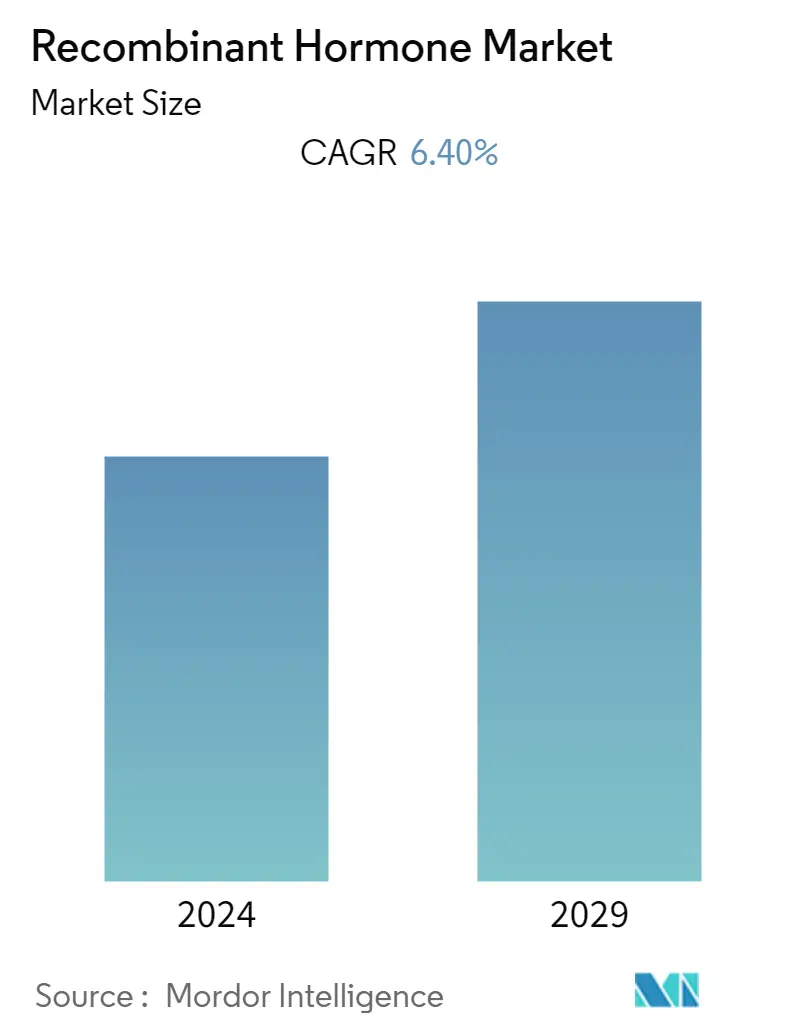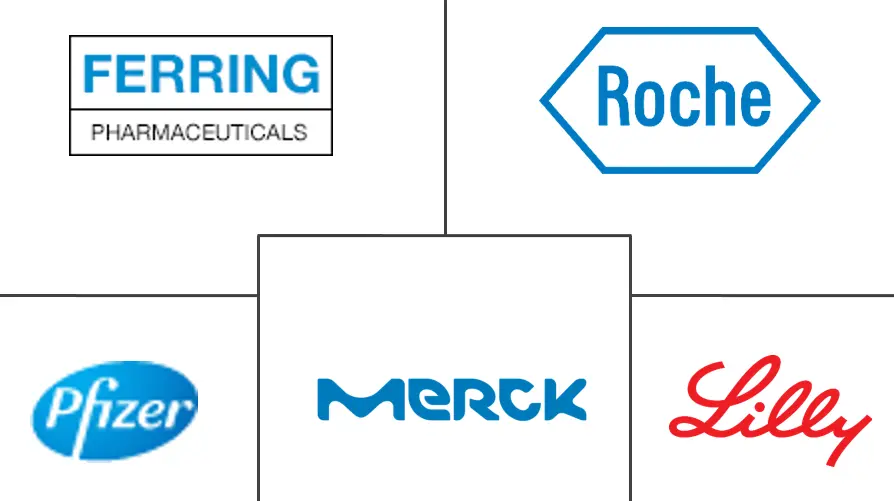Market Size of Recombinant Hormone Industry

| Study Period | 2019 - 2029 |
| Base Year For Estimation | 2023 |
| Forecast Data Period | 2024 - 2029 |
| CAGR | 6.40 % |
| Fastest Growing Market | Asia-Pacific |
| Largest Market | North America |
Major Players
*Disclaimer: Major Players sorted in no particular order |
Recombinant Hormone Market Analysis
The recombinant hormone market is expected to register a CAGR of 6.4% over the forecast period.
COVID-19 is expected to drive the growth of the recombinant hormone market. The increased risk for diseases like diabetes during the COVID-19 outbreak is expected to drive the demand for recombinant hormones like insulin in the market. For instance, in February 2022, Massachusetts General Hospital stated that, in COVID-19 hospital admissions worldwide, high rates of newly diagnosed Diabetic Mellitus (NDDM) had been recorded. This high rate of new diabetes cases increases the need for recombinant insulin. Thus, the outbreak of COVID-19 is expected to drive the growth of the recombinant hormone market during the pandemic period. However, as the pandemic has been subsidized, the market is expected to project stable growth due to the application of recombinant hormones in different diseases.
The major factors that drive the market include the increasing or high burden of growth disorders and diabetes and technological advancements in the development of recombinant hormonal therapies. For instance, as per the IDF Diabetes Atlas 2021, the number of adults that are living with diabetes worldwide is estimated to be 537 million. This high burden of diabetes increases the need for advanced treatment using recombinant insulin and is expected to drive the market over the study period.
Furthermore, the new research studies on the recombinant hormones for accessing the safety profile increase the widespread of the products that help boost the market's growth. For instance, as per the study report published by Frontiers in Endocrinology in July 2022, PEGylated recombinant human growth hormone, Jintrolong, exhibited good long-term safety in cynomolgus monkeys and human pediatric growth hormone deficiency patients. The better safety profile of the product increases the usage of the drug and is expected to propel the market over the forecast period.
Hence, the factors like the high burden of diabetes and new research studies on recombinant hormones are expected to increase the usage of recombinant hormones and likely boost the market growth. However, adverse effects associated with recombinant hormonal therapies and stringent regulatory processes are the factors that hinder market growth over the forecast period.
Recombinant Hormone Industry Segmentation
The recombinant hormone is the hormone made in a laboratory using recombinant technology, which is used for therapeutic purposes. The Recombinant Hormone Market is segmented by Product Type (Growth Hormone, Insulin, Follicle-stimulating Hormone, Other Products) and Geography (North America, Europe, Asia-Pacific, Middle East and Africa, and South America). The market report also covers the estimated market sizes and trends for 17 countries across major regions globally. The report offers the value (in USD million) for the above segments.
| By Product Type | |
| Growth Hormone | |
| Insulin | |
| Follicle-stimulating Hormone | |
| Other Products |
| Geography | ||||||||
| ||||||||
| ||||||||
| ||||||||
| ||||||||
|
Recombinant Hormone Market Size Summary
The recombinant hormone market is poised for significant growth, driven by the increasing prevalence of diabetes and advancements in hormonal therapies. The COVID-19 pandemic has further accelerated demand, particularly for recombinant insulin, due to the rise in diabetes cases among hospitalized patients. Technological innovations and new research findings, such as the improved safety profiles of products like PEGylated recombinant human growth hormone, are expanding the application and acceptance of these therapies. Despite challenges like adverse effects and regulatory hurdles, the market is expected to benefit from the high burden of growth disorders and diabetes, which necessitate advanced treatment options.
North America is anticipated to maintain a dominant position in the recombinant hormone market, supported by substantial research funding and a robust healthcare infrastructure. The region's market growth is further bolstered by new product launches, such as SKYTROFA and PrNGENLA, which cater to pediatric patients with growth hormone deficiencies. The market is characterized by a few major players, with ongoing collaborations and mergers expected to drive innovation and technology sharing. Companies like Eli Lilly, Pfizer, and Novo Nordisk are key players, actively expanding their product portfolios through strategic acquisitions and regulatory approvals. These factors collectively contribute to the anticipated expansion of the recombinant hormone market over the forecast period.
Recombinant Hormone Market Size - Table of Contents
-
1. MARKET DYNAMICS
-
1.1 Market Overview
-
1.2 Market Drivers
-
1.2.1 Increasing Incidence of Growth Disorders and Diabetes
-
1.2.2 Technological Advancements in Development of Recombinant Hormonal Therapies
-
-
1.3 Market Restraints
-
1.3.1 Adverse Effects Associated with Recombinant Hormonal Therapies
-
1.3.2 Stringent Regulatory Processes
-
-
1.4 Porter's Five Forces Analysis
-
1.4.1 Threat of New Entrants
-
1.4.2 Bargaining Power of Buyers/Consumers
-
1.4.3 Bargaining Power of Suppliers
-
1.4.4 Threat of Substitute Products
-
1.4.5 Intensity of Competitive Rivalry
-
-
-
2. MARKET SEGMENTATION (Market Size by Value - USD million)
-
2.1 By Product Type
-
2.1.1 Growth Hormone
-
2.1.2 Insulin
-
2.1.3 Follicle-stimulating Hormone
-
2.1.4 Other Products
-
-
2.2 Geography
-
2.2.1 North America
-
2.2.1.1 United States
-
2.2.1.2 Canada
-
2.2.1.3 Mexico
-
-
2.2.2 Europe
-
2.2.2.1 Germany
-
2.2.2.2 United Kingdom
-
2.2.2.3 France
-
2.2.2.4 Italy
-
2.2.2.5 Spain
-
2.2.2.6 Rest of Europe
-
-
2.2.3 Asia-Pacific
-
2.2.3.1 China
-
2.2.3.2 Japan
-
2.2.3.3 India
-
2.2.3.4 Australia
-
2.2.3.5 South Korea
-
2.2.3.6 Rest of Asia-Pacific
-
-
2.2.4 Middle East and Africa
-
2.2.4.1 GCC
-
2.2.4.2 South Africa
-
2.2.4.3 Rest of Middle East and Africa
-
-
2.2.5 South America
-
2.2.5.1 Brazil
-
2.2.5.2 Argentina
-
2.2.5.3 Rest of South America
-
-
-
Recombinant Hormone Market Size FAQs
What is the current Recombinant Hormone Market size?
The Recombinant Hormone Market is projected to register a CAGR of 6.40% during the forecast period (2024-2029)
Who are the key players in Recombinant Hormone Market?
Eli Lilly and Company, Ferring Pharmaceuticals, F.Hoffmann-La Roche Ltd (Genentech, Inc), Merck & Co Inc (Merck KGaA) and Pfizer Inc are the major companies operating in the Recombinant Hormone Market.

